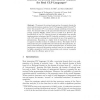Free Online Productivity Tools
i2Speak
i2Symbol
i2OCR
iTex2Img
iWeb2Print
iWeb2Shot
i2Type
iPdf2Split
iPdf2Merge
i2Bopomofo
i2Arabic
i2Style
i2Image
i2PDF
iLatex2Rtf
Sci2ools
LPAR
2000
Springer
2000
Springer
Efficient Structural Information Analysis for Real CLP Languages
We present the rational construction of a generic domain for structural information analysis of real CLP languages called Pattern(D ), where the parameter D is an abstract domain satisfying certain properties. Our domain builds on the parameterized domain for the analysis of logic programs Pat( ), which is due to Cortesi et al. However, the ation of our CLP abstract domain is independent from specific implementation techniques: Pat( ) (suitably extended in order to deal with CLP systems omitting the occurs-check) is one of the possible imtions. Reasoning at a higher level of abstraction we are able to appeal to familiar notions of unification theory. This higher level of abstraction also gives considerable more latitude for the implementer. Indeed, as demonstrated by the results summarized here, an analyzer that incorporates structural information analysis based on our approach can be highly competitive both from the precision and, contrary to popular belief, from the efficiency point ...
Abstract Domain | Automated Reasoning | CLP Abstract Domain | LPAR 2000 | Structural Information Analysis |
| Added | 25 Aug 2010 |
| Updated | 25 Aug 2010 |
| Type | Conference |
| Year | 2000 |
| Where | LPAR |
| Authors | Roberto Bagnara, Patricia M. Hill, Enea Zaffanella |
Comments (0)

